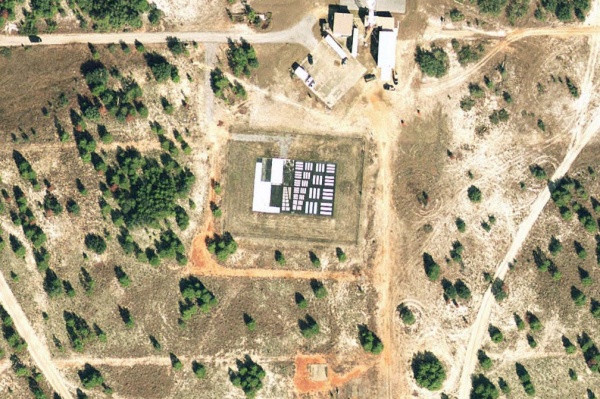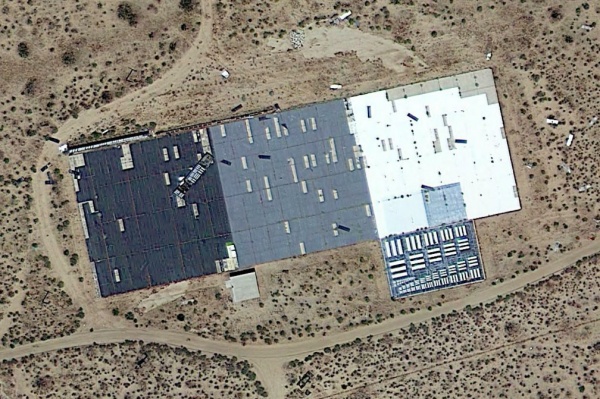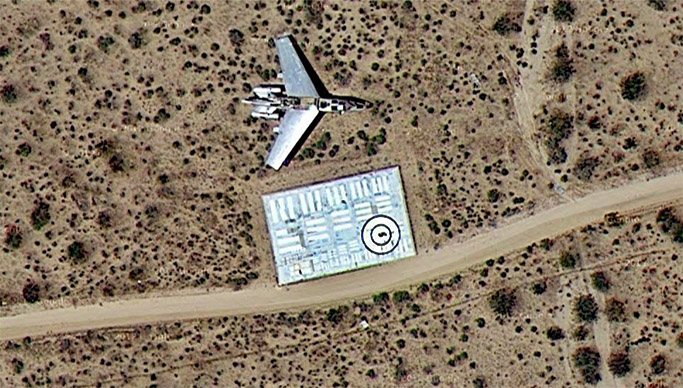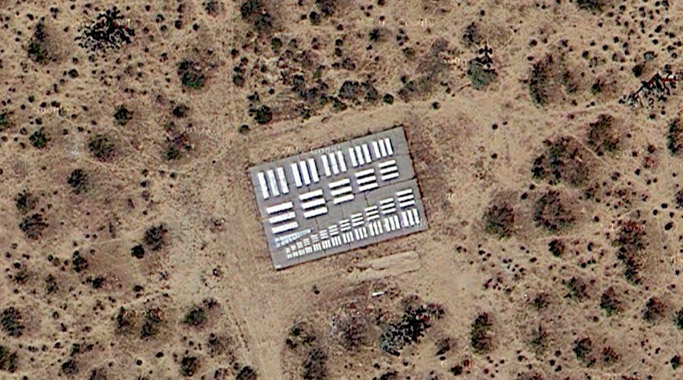 [Image: “Three tri-bar targets remaining at Cuddeback Lake… the flat surfaces are peeling, crumbling and sprouting, producing dimensionality, and relief.” Photo by and courtesy of the Center for Land Use Interpretation].
[Image: “Three tri-bar targets remaining at Cuddeback Lake… the flat surfaces are peeling, crumbling and sprouting, producing dimensionality, and relief.” Photo by and courtesy of the Center for Land Use Interpretation].
“There are dozens of aerial photo calibration targets across the USA,” the Center for Land Use Interpretation reports, “curious land-based two-dimensional optical artifacts used for the development of aerial photography and aircraft. They were made mostly in the 1950s and 1960s, though some apparently later than that, and many are still in use, though their history is obscure.”
These symbols—like I-Ching trigrams for machines—are used as “a platform to test, calibrate, and focus aerial cameras traveling at different speeds and altitudes,” CLUI explains, similar to “an eye chart at the optometrist, where the smallest group of bars that can be resolved marks the limit of the resolution for the optical instrument that is being used.”
 [Image: A tri-bar array at Eglin Air Force Base, Florida; via CLUI].
[Image: A tri-bar array at Eglin Air Force Base, Florida; via CLUI].
Formally speaking, the targets could be compared to mis-painted concrete parking lots in the middle of the nowhere, using “sets of parallel and perpendicular bars duplicated at 15 or so different sizes.” This “configuration is sometimes referred to as a 5:1 aspect Tri-bar Array, and follows a similar relative scale as a common resolution test chart known as the 1951 USAF Resolving Power Test Target, conforming to milspec MIL-STD-150A. This test pattern is still widely used to determine the resolving power of microscopes, telescopes, cameras, and scanners.”
 [Image: A “standard tri-bar test pattern on the Photo Resolution Range at Edwards that has been greatly expanded,” CLUI writes; via CLUI].
[Image: A “standard tri-bar test pattern on the Photo Resolution Range at Edwards that has been greatly expanded,” CLUI writes; via CLUI].
CLUI points out that the history and location of the tri-bar patterns corresponds to the rise of high-altitude “flying cameras” developed during the Cold War—i.e. spy planes whose purpose was not to deliver ordnance to the far side of the world but simply to take detailed photographs.
 [Image: An “especially exotic” expanded tri-bar array at Fort Huachuca, Arizona; via CLUI].
[Image: An “especially exotic” expanded tri-bar array at Fort Huachuca, Arizona; via CLUI].
Further, “the largest concentration of calibration targets in one place is on the grounds of Edwards Air Force Base” in California, “in an area referred to as the photo resolution range, where 15 calibration targets run for 20 miles across the southeast side of the base in a line, so multiple targets can be photographed in one pass. There is some variation in the size and shape of the targets at Edwards, suggesting updates and modifications for specific programs. A number of the targets there also have aircraft hulks next to them, added to provide additional, realistic subjects for testing cameras.”
A quick scan of Google Maps locates the photo resolution range relatively easily; broadly speaking, just go up to the right and down to the left from, say, this point and you’ll find the targets.



 [Image: Calibration targets from the photo resolution range, Edwards Air Force Base; from Google Maps].
[Image: Calibration targets from the photo resolution range, Edwards Air Force Base; from Google Maps].
Although I am truly fascinated by what sorts of optical landmarks might yet be developed for field-testing the optical capabilities of drones, as if the world might soon be peppered with opthalmic infrastructure for self-training autonomous machines, it is also quite intriguing to realize that these calibration targets are, in effect, ruins, obsolete sensory hold-overs from an earlier age of film-based cameras and less-powerful lenses. Calibrating nothing, they are now just curious emblems of a previous generation of surveillance technology, robot-readable hieroglyphs whose machines have all moved on.

What the heck is that craft parked by the target in the sixth image down?
The photo with the plane in it puzzled me for a bit, as it's an odd-looking beastie. Finally figured out it's what's left of one of the two X-21s ever built.
That plane is kinda sad … feels like such a rare vehicle should be treated better than this: http://home.earthlink.net/~enigmaep/bombrange/rng_6-34.jpg
I grew up on Elgin AFB through the late sixties and the seventies. And let’s say there’s
A LOT of historical “anomalies” and “places” cross that huge reservation. Wild to explore as a adolescent boy. I always describe my rearing as being in “Lord of the Flies.”